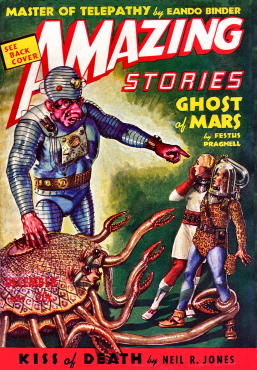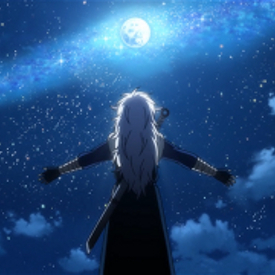
When this is published—tomorrow, December 13—it will be my 26th consecutive published weekly column. (Yes, purists, I know it’s a blog entry, but last time I was published in Amazing on a regular basis I was a columnist, plus—as Graeme Cameron says—I’m an older guy, so I’ll keep on calling it a column. Deal with it.) As we all know, 26 weeks is precisely half a year, so I’m doing a small celebratory column.
My mother informed me, when I was doing my fan column in the ‘80s, that my paternal grandfather used to read this magazine, so I thought it would be good to review the December 1938 Amazing, exactly 75 years ago. Unfortunately, the last 1938 issue I have is August, darn it, so I’ll review that one instead. Just for general interest I’m adding (Photo 1) the cover for the December 1938 issue, by Joseph Wirt Tillotson under his “brush name” of Robert Fuqua. (Thanks to Amazing blogger Jane Frank for that tidbit of artist information.)
The August 1938 issue of Amazing has a photographic cover by Henry F. Kroeger Jr.; I personally, have never really cared for photographic SF/F covers. I will make exception for some 3D rendered covers, but mostly I just prefer art. The only other Amazing cover I can think of that was a photograph was the June 1938 one, and that was worse than this cover; Amazing abandoned the attempt at photographic SF covers after this one and went back to art.

According to the editorial—credited just to The Editor, but we now know that person was Ray Palmer (Raymond A. Palmer), he of the Shaver Mystery and later Fate magazine; Palmer edited Amazing from 1938, when Ziff-Davis acquired the magazine and T. O’Conor Sloane resigned as editor, to about 1949, when he left to do Fate. (I might hit up the Shaver Mystery in a later column; it’s really weird.) What kind of editor was he? Truth be told, by modern standards he wasn’t very good; all the stories in this issue are short on literary quality, even by SF standards of the time. He touts three new authors: Robert Bloch, Arthur Tofte and A.R. Steber. Bloch, at 21, was already a weird fiction author, but had decided to try SF; this was his first SF sale—and years before he wrote Psycho. Both Tofte and Steber said this was their first sale, but I think only Tofte went on to become a minor “name” in SF. The stories—and all stories in this magazine are “scientifically accurate” according to the banner on the cover (“accurate” here meaning “somewhat plausible” if you stretch the meaning of “plausible”)—range from space opera to monsters of various sorts—vegetables and killer bacteria. The magazine is well illustrated by Jay Jackson and Harold Welch in that ‘thirties style of SF illustration where there are lots of tubes (both vacuum and otherwise), rays, wires and so on. Many of the illos could have come right out of a detective magazine, though. Nothing is really “deco,” but it’s enjoyable to see how illustration changes from decade to decade. There are people in space suits fighting with people not in space suits (the story is “Kidnappers of Space” by Thorp McClusky, illustrated by Jackson), and all are wearing jodhpurs! Shades of Northwest Smith!*
For those of you of the younger persuasion, Northwest Smith was a character by C.L. Moore who lived by his wits (similar to Leigh Brackett’s Eric John Stark of Mars); there’s a well-known picture of E.E. “Doc” Smith dressed up as “Northwest Smith” at a convention… and he’s wearing jodhpurs. This is the first colour picture I’ve ever seen of Doc as Northwest Smith, by the way.

The stories in this issue include Bloch’s “Secrets of the Observatory” (the cover story)—which, seen from 75 years later, is incredibly racist. The U.S. had not yet entered into the war that was to begin in less than a year, yet the villains of this superscience story were “Orientals”—mostly Japanese (the epithet “Japs” comes up a few times), although there is a “brutish Mongol” involved as well. The story revolves around the attempt to steal American war secrets and a special camera that could see through walls. The women in this and the rest of the stories are also treated, by today’s standards, in a very sexist way. Although we can’t judge a 75-year-old story by today’s social standards, it does make a modern reader kind of embarrassed. (Yeah, I’m talking about me.) There’s a monster story (Arthur Tofte’s story about intelligent invading potatoes from space — hey, that’s what the illo shows!) and a story by A.R. Steber about a “blinding ray” that is used in war. It appears that war, although not yet involving the whole Earth in reality, was very much on people’s minds. (The ray cited was a variation on “infra” rays, which according to editorial comment, were already being successfully used to treat gangrene and other diseases.)
Although the stories had some good ideas, the writing was definitely not anywhere near the standards we expect today in our SF. For example: “You scamp!” roared Hadlock. “Maybe,” grinned Hugh. Today we prefer that our characters say things rather than roaring and grinning them; it’s a sloppy shorthand attempt at characterization that no longer goes down well with readers. (One name for it is “said-bookism.”) The stories are, by and large, forgettable, though not any worse for the time than many others being published.
There were also departments, like an editorial, a letter column—and here the magazine was taken to task for not providing commenters’ addresses so that correspondence could be entered into outside the pages of the magazine; Palmer said the magazine would leave that up to the readers to decide. Letters in this issue came from Milton A. Rothman and Donald A. Wollheim, among others; some decrying the magazine’s new look under Ziff-Davis (“Sirs: Your revised Amazing Stories stinks!”) and some praising it. Things like that haven’t changed, have they? There was a science quiz, a science facts column and an “about our authors” column; and the back cover had a science feature about the composition of the Earth’s crust and core. All in all, Amazing just before the war was kind of average—though Palmer managed to stay editor for 11 years and, one presumes, made money for the company.

Last week, I talked about Modesty Blaise, but it seems to me that I never mentioned exactly why she was popular or what the stories were about! I think I can rectify this fairly quickly. Again, I must stress that I have read few of the strips; I came to Modesty through the books, which to me remain some of the best action/adventure books I know.
The adventures Modesty and Willie Garvin, her right-hand man and partner, are involved in often start as fairly ordinary capers, but usually end up somewhere really off the beaten path; the villains range from an autistic person who can tell who in a group of people is going to die soon (I, Lucifer) to a giant of a man (Simon Delicata) who can feel no pain and is totally immoral (A Taste For Death); to a man who keeps a real slave plantation in Central America because he’s a momma’s boy and momma wants it (Last Day in Limbo). Modesty and Willie usually start the book with some feat that figures later in the book; if, for example, she demonstrates archery skills in their exercise room at The Treadmill (Willie’s pub), archery will be important in saving their butts later. Modesty is excellent at physical combat, and also an expert shot with a handgun, her favourite being a MAB-25 (a French handgun). When doing hand-to-hand she likes to use a kongo; it’s a piece of wood with mushroom-shaped ends, which she uses to hit nerve endings below the skin.
Willie Garvin, on the other hand, is hopeless with a handgun, although he’s an expert rifle shot. His chief weapon, when not doing hand-to-hand, is the pair of handmade knives he wears in sheaths across his chest. He can throw them as accurately, though not as far, as Modesty can aim her MAB. Modesty is also an expert fencer, and Willie knows electronics and explosives. Between them they are equal to (or maybe better than!) Derek Flint, and are what James Bond can only hope to be; their skills and talents have saved the day more than Bond could dream of, doing it either for Queen and Country (they are, in their own way, patriots) or to help friends. Their friends include Stephen Collier and his wife, Dinah, who is a blind psychic; an American millionaire; a number of people from their days running The Network, and so on. Modesty and Willie are partners, but never lovers; they have a unique friendship and relationship otherwise, and to become physical lovers would, they feel, spoil that. As I said (see Photo 3), Quentin Tarantino is a big fan.

And finally, we come to a book review. The book is called Vampire Siege at Rio Muerto, by Amazing blogger John M. Whalen, from Flying W. Press. Don’t worry that I will cheat in any way on my review just because John’s a fellow Amazing blogger; I will give the book a fair and impartial review. It’s available for the Kindle from Amazon at a price of just over $4, which in my opinion’s a fair price.
The book is that rare thing, a vampire Western. Vampires and werewolves abound in this book, and it is set in the latter part of the nineteenth century in New Mexico. The chief protagonist is one Mordecai Slate, bounty hunter. According to the cover, he looks kinda like a low-rent Lee Van Cleef. In the beginning of the book, he’s working for the Wyoming Central Railway. There’s a gang of outlaws—only Slate knows they’re actually werewolves—who’ve been robbing trains and killing all the passengers. Slate must find them and kill them.
As the book opens, we meet one Don Pedro Sanchez, patron of a big hacienda near Socorro, New Mexico, who has just lost his only daughter to the vampires. Recently buried, she is sealed within her coffin, but the Don has to do the deed and finish her off; after he has done this awful thing he sends for Slate with one aim: Slate must find the chief vampiro, one Kord Manion, who turned the Don’s daughter, and bring him back to the hacienda for execution. Although Slate’s killed weres for as little as $500 each, he gets the Don to agree to $15,000 for Manion.
Because vampire fiction is everywhere these days, I’ve read all kinds of vampire books, but seldom any vampire Westerns. As vampire books go, this has all the action of, say, the Blade movies—lots of people are bitten, lots of vamps are killed, and there’s a vampire plot to take over the world. I won’t say Slate is the equivalent of Blade, because he’s all human, not half-vamp (or dhampir, as the Hendees would say) and he just doesn’t have the charisma of a Wesley Snipes. But he is ruthless, and he’s out to kill all kinds of monsters—werewolves, zombies, vamps—as long as he gets paid for it!
As Westerns go, it’s not as well written as a Louis L’Amour; I’d say it was about the equivalent of one of the more recent series, like the Longarm series written by “Tabor Evans” (a “house name” hiding a number of authors) which started in 1978 and still continues, as far as I know. It’s got action, the requisite Western setting and an air of—if not complete authenticity, at least plausibility—the author knowing both his Western stuff and his settings. There’s no romance, and the characters are not—even including Slate—terribly deep. But depth is not necessarily what one wants when reading Westerns. I’ve been reading various Western authors since the early 1960s, and I’d say this book can hold its own, at least. As usual, I’m not going to give too much plot away, though in a book like this you can be pretty sure the protagonist’s going to win. I suspect Slate will be back in another book, and that’s okay!
Because I read a preproduction copy, there are lots of editing issues, which I hope got corrected in the final: em dashes that are still double hyphens; “your” instead of “you’re”; other editing glitches—but these will probably only bother those of us who are professional writers and/or readers. They shouldn’t interfere with your enjoyment of the book. The cover, too, is a bit clumsy—and it looks like the artist didn’t really do her research about the rifle, a Colt 1855 revolver rifle (which has a revolver-type cylinder). And I’m not crazy about the title font, with all those fancy swashes, which to me don’t scream “Western,” but again, I may be nitpicking. I can recommend this book to lovers of Western series who also like vampires. It’s a good monster/action book.
As always, my opinion is mine alone—don’t be afraid to argue with me. Everything I say, with the exception of hard facts, is only what I think. So please comment; you can do so on Facebook; I post links in several fannish groups—or if you want to post them here you can register—if you haven’t already—and comment on the Amazing Stories website. Next week, more fannish stuff.










Whew! Thanks for the great review, Steve. I was sweating it out when I heard you were doing the review. I know from personal experience how tough you can be. “Low rent Lee Van Cleef!” I’ll accept that.